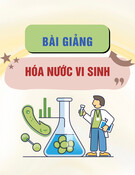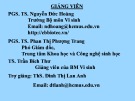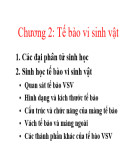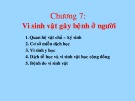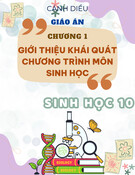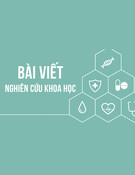GIẢNG VIÊN
PGS. TS. Nguyễn Đức Hoàng Trưởng Bộ môn Vi sinh Email: ndhoang@hcmus.edu.vn http://cbbiotec.vn/
PGS. TS. Phan Thị Phượng Trang
Phụ trách đào tạo NCS của Bộ môn Vi sinh Phó Giám đốc TT Khoa học và CNSH
TS. Trần Bích Thư
Giảng viên của BM Vi sinh
Trợ giảng: ThS. Đinh Thị Lan Anh
Email: dtlanh@hcmus.edu.vn
• “Microbiology is the study of microorganisms.
Microorganisms are all (single-celled) microscopic organisms and include the viruses, which are microscopic but not cellular”.
• “Microbial cells differ in a fundamental way from
the cells of plants and animals in that microorganisms are independent entities that carry out their life processes independently of other cells. By contrast, plant and animal cells are unable to live alone in nature and instead exist only as parts of multicellular structures, such as the organ systems of animals or the leaves of plants”.
Brock Microbiology of Microorganism (13th)
VI SINH VAÄT HOÏC CÔ SÔÛ
CHÖÔNG 1 Môû ñaàu CHÖÔNG 2 Teá baøo vi sinh vaät
Caùc ñaïi phaân töû sinh hoïc Sinh hoïc teá baøo vi sinh vaät
CHÖÔNG 3 Sinh lyù vi sinh vaät
Dinh döôõng vaø bieán döôõng Taêng tröôûng Kieåm soaùt taêng tröôûng Söï ña daïng veà phöông thöùc bieán döôõng
CHÖÔNG 4 Di truyeàn hoïc vi sinh vaät
Di truyeàn phaân töû Ñieàu hoøa söï theå hieän cuûa gen Viruùt vaø di truyeàn hoïc vi sinh vaät Kyõ thuaät di truyeàn vaø coâng ngheä sinh hoïc
CHÖÔNG 5 Tieán hoùa vaø ña daïng vi sinh vaät
Tieán hoùa vaø heä thoáng hoïc phaân töû vi sinh vaät Vi ruùt Vi khuaån Vi khuaån coå Vi sinh vaät nhaân thaät
CHÖÔNG 6 Sinh thaùi hoïc vi sinh vaät CHÖÔNG 7 Vi sinh vaät gaây beänh ôû ngöôøi Quan heä vaät chuû – kyù sinh Moät soá cô sôû mieãn dòch hoïc Vi sinh y hoïc Dòch teã hoïc vaø vi sinh vaät hoïc coäng ñoàng Beänh do vi sinh vaät
CHÖÔNG 8 ÖÙng duïng vi sinh vaät
Vi sinh vaät hoïc coâng nghieäp Coâng ngheä sinh hoïc phaân töû vi sinh vaät
Resources
Brock Biology of Microorganism
14th Ed, 2015
Madigan, Martinko, Bender, Buckley, Stahl
ASM Curriculum guidelines for undergraduate microbiology
http://www.asm.org/index.php/guidelines/curriculum-guidelines
ASM: American Society for Microbiology
Đánh giá
• 20% Quá trình (câu hỏi ngắn, tự luận, seminar)
• 20% Thi giữa kỳ • 60% Thi cuối kỳ
Chöông 1: Môû ñaàu
Vi sinh vaät hoïc
- Muïc tieâu:
+ nghieân cöùu ñôøi soáng, hoaït ñoäng cuûa teá baøo + söï ña daïng, söï tieán hoùa ôû vi sinh vaät + hoaït ñoäng trong töï nhieân + vai troø trong xaõ hoäi loaøi ngöôøi, cô theå con ngöôøi, ñoäng vaät vaø thöïc vaät - YÙ nghóa khoa hoïc cuûa vi sinh vaät hoïc:
+ coâng cụ, moâ hình öu vieät ñeå nghieân cöùu caùc quaù
trình soáng cuûa teá baøo
+ coù theå nuoâi ôû maät ñoä raát cao trong ñieàu kieän phoøng
thí nghieäm
+ thôøi gian theá heä ngaén, deã duøng trong caùc nghieân
cöùu sinh hoùa vaø di truyeàn
- YÙ nghóa thöïc tieãn: coù vai troø quan troïng trong y hoïc, noâng nghieäp vaø coâng nghieäp.
Ñaëc tính teá baøo ôû vi sinh vaät
- Nhöõng ñaëc ñieåm soáng cuûa teá baøo vi sinh vaät
+ Bieán döôõng + Sinh saûn + Phaân hoùa + Giao tieáp, ñaùp öùng thích nghi + Ña soá coù khaû naêng di ñoäng + Tieán hoùa vaø di truyeàn
- Chöùc naêng:
+ Chuyeån hoùa vaät chaát + Maõ hoùa thoâng tin
- Bieán döôõng cung caáp naêng löôïng ñeå teá baøo giöõ caáu truùc oån ñònh vaø toång hôïp caùc hôïp chaát ñeå caáu truùc thaønh phaàn cuûa teá baøo
Bieán döôõng
Ñaëc tính teá baøo ôû vi sinh vaät
Sinh saûn (taêng tröôûng)
Bieät hoùa
Ñaëc tính teá baøo ôû vi sinh vaät
Giao tieáp
Ñaëc tính teá baøo ôû vi sinh vaät
Di ñoäng
Tieán hoùa
Đặc điểm của tế bào vi sinh vật
Chöùc naêng teá baøo ôû vi sinh vaät
- Chöùc naêng:
+ Chuyeån hoùa vaät chaát + Maõ hoùa thoâng tin
- Bieán döôõng cung caáp naêng löôïng ñeå teá baøo giöõ caáu truùc oån ñònh vaø
toång hôïp caùc hôïp chaát ñeå caáu truùc thaønh phaàn cuûa teá baøo
Hai daïng teá baøo
- Teá baøo tieàn nhaân (prokaryote) - Teá baøo nhaân thaät (eukaryote) - Viruùt?
Ba giôùi sinh vaät
Theá giôùi sinh vaät goàm ba giôùi (trình töï nucleotide cuûa rRNA):
+ Vi khuaån (Bacteria) + Vi khuaån coå (Archaea) + Sinh vaät nhaân thaät (Eukarya)
Vi sinh vaät trong töï nhieân vaø chuûng thuaàn trong phoøng thí nghieäm
- Trong töï nhieân, söï taêng tröôûng vaø hoaït ñoäng cuûa vi sinh vaät coù quan heä chaëït cheõ vôùi caùc yeáu toá sinh thaùi.
- Haàu heát caùc kieán thöùc hieän coù veà vi sinh vaät döïa treân
caùc nghieân cöùu treân caùc chuûng thuaàn trong phoøng thí nghieäm.
Vi sinh vaät vaø con ngöôøi
- Ñaïi ña soá vi sinh vaät laø “baïn”:
+ Veà noâng nghieäp: coá ñònh ñaïm cho caây troàng; tuaàn hoaøn caùc chaát dinh döôõng trong ñaát; giuùp gia suùc tieâu hoùa coû, rôm thaønh thòt… + Veà thöïc phaåm: taïo caùc thöïc phaåm leân men (bia, röôïu, phoâmai, yaourt…); keùo daøi thôøi gian baûo quaûn; taïo caùc phuï gia thöïc phaåm… + Veà coâng nghieäp: taïo ra caùc dung moâi höõu cô, caùc chaát dinh döôõng, vitamin, sinh khoái… + Veà y teá: saûn xuaát khaùng sinh, giuùp oån ñònh heä vi khuaån ñöôøng ruoät + Veà moâi tröôøng: phaân huûy caùc chaát thaûi, caûi thieän moâi tröôøng bò oâ nhieãm thuoác tröø saâu, thuoác dieät coû… + Veà naêng löôïng: taïo khí methane duøng laøm nhieân lieäu; taïo H2 töø naêng löôïng aùnh saùng vaø caùc nguoàn naêng löôïng voâ cô, höõu cô duøng laøm nguoàn naêng löôïng taùi sinh cuûa töông lai. + Coù vai troø khoâng theå thieáu trong Coâng ngheä Sinh hoïc hieän ñaïi.
- Moät soâ ít vi sinh vaät laø “thuø”:
+ Gaây beänh treân ngöôøi + Gaây beänh treân vaät nuoâi + Gaây beänh treân caây troàng.
Impact
24. Because the true diversity of microbial life is
largely unknown, its effects and potential benefits have not been fully explored
25. Humans utilize and harness microbes and their
products
26. Microbes are essential for life as we know it and
the processes that support life
27. Microorganisms provide essential models that give us fundamental knowledge about life processes
Bối cảnh lịch sự phát triển Vi sinh vật học
Lòch söû nghieân cöùu vi sinh vaät
Lòch söû nghieân cöùu vi sinh vaät
The discovery of microorganisms
• Robert Hooke (1635- 1703): he illustrated fruiting structures of molds – the first known description of microorganisms in 1665
• Antoni van Leeuwenhoek (1632-
1723): the first person to see bacteria, the smallest microbial cells, in 1676 (khác nhau vì tài liệu tham khảo)
A replica of Antoni van Leeuwenhoek‘s microscope
A photograph of human bacteria taken by a Leeuwenhoek microscope
Leeuwenhoek‘s drawings of bacteria, published in 1648
• Ferdinand Cohn (1828-1898: endospore
(bacteria), laid the groundwork for a system of bacterial classification and devised man
• Developed highly effective methods for preventing the contamination of culture media (such as use of cotton for closing flasks and tubes)
Drawing by Ferdinand Cohn of the large filamentous sulfur oxidizing bacterium Beggiatoa
Pasteur and spontaneous Generation
Major advances in microbiology were made in the nineteenth century because of the interest in two major questions of the day:
(1) Does spontaneous generation occur?
(2) What is the nature of infectious disease?
From Optical Isomers and Fermentations
Pasteur (Chemist) discovered that the mold Aspergillus metabolized D-tartrate, which bent light to the right, but did not metabolize its optical isomer, L-tartrate.
Pasteur initiated studies on the mechanism of the alcoholic fermentation, which in the mid-nineteenth century was assumed to be a strictly chemical process
The yeast cells in the fermenting
broth were thought to be some sort of chemical substance
formed by the fermentation. However, microscopic
observations and other simple but rigorous experiments
convinced Pasteur that the alcoholic fermentation was catalyzed
by living microorganisms, the yeast cells. From these
foundational studies, Pasteur began a series of classic
experiments on spontaneous generation, experiments that are
forever linked to his name and to the science of microbiology.
Spontaneous Generation
The concept of spontaneous generation had existed since biblical
times and its basic tenet can be easily grasped.
If food or some other perishable material is allowed to stand for
some time, it putrefies. When examined microscopically, the
putrefied material is teeming with microorganisms. From where do
these organisms arise? Some people said they developed from
seeds or germs that entered the food from air. Others said they
spontaneous generation. Who was right?
arose spontaneously from nonliving materials, that is, by
Thí nghieäm phuû ñònh thuyeát VSV phaùt sinh ngaãu nhieân (Pasteur, 1864)
• Living organisms developed from seeds or germs that entered the food from air. • Pasteurization French 5-franc note
method • Vaccine
development (anthrax, fowl cholera and rabies)
Part of Pasteur institute
The medical and veterinary breakthroughs of
Pasteur were not only highly significant in their
own right but helped solidify the concept of the
germ theory of disease, whose principles were
being developed at about the same time by a
second giant of this era, Robert Koch.
Koch, Infectious Disease, and pure cultures
Proof that some microorganisms cause disease provided the greatest impetus for the development of microbiology as an independent biological science.
The German physician Robert Koch (1843–1910) was developed and given direct experimental support for the concept of infectious disease
Robert Koch













